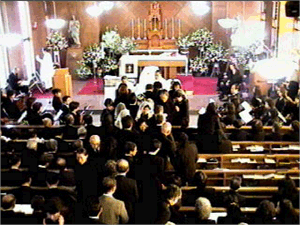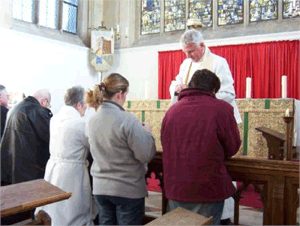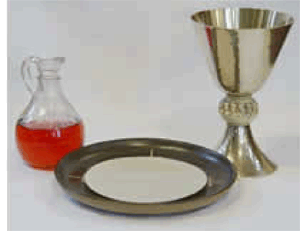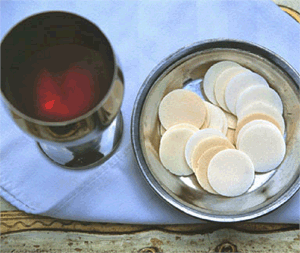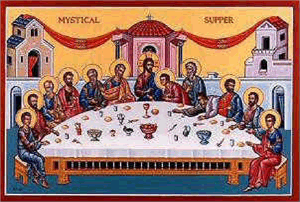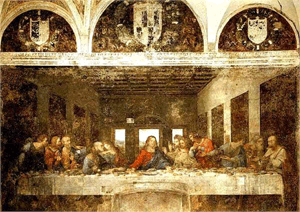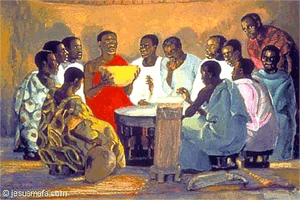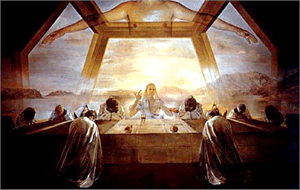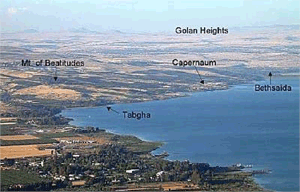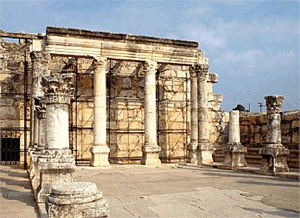
Christmas
Easter
Pentcoest
All Saints
Christ The King
Confirmation
Palm/Passion
Reformation
Stewardship
Books of the Bible
Lenten Series
Christmas Dramas
Videos
Series A - Matthew
Series B - Mark
Series C - Luke
Series D - Other
To contact
Edward F. Markquart
info@sfs.com
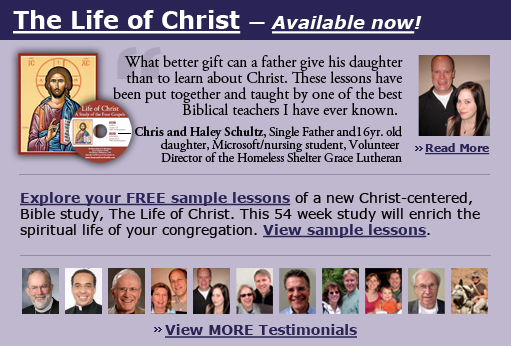
Pentecost 11B John 6:51-58 Holy Communion is the most sacred event in the Christian Church. When people receive the body and blood of Jesus Christ during Holy Communion, we know that this is a most sacred time. A holy time. A blessed time. Mysterious and unexplainable. What do people feel is the most important part of the worship service? In the recent past, when studies were made within the Lutheran church, 83% of Lutherans rated Holy Communion as the most important part of the worship service. More important than preaching. More important than singing hymns and praise songs. More important than praying and the prayers of the church. Within our Lutheran community, the reception of Holy Communion and the experience of Holy Communion and the words of Holy Communion ring clear as a bell within our spiritual lives. But why? Why is Holy Communion so consistently sacred and moving to so many Christians? What is there about Holy Communion which is so special? Why does Holy Communion consistently touch lives so deeply? I think the gospel lesson for today speaks to these questions. We know experiences of Holy Communion. Such experiences are common to us. We see members of a congregation coming forward to receive the sacrament. http://mrdata.com/fandrich/eric/suzuki/images/mass/mass2.jpeg
http://www.tattershall.net/100_0624.JPG
In our mainline denominations, the pastor is often wearing vestments, especially at the traditional worship services. We think of the bread and wine of Holy Communion. http://www.holyangelssidney.com/images/chalice-bread-wine.jpg
http://www.painetworks.com/photos/hf/hf1576.JPG
In the past, there have been famous paintings about Holy Communion. Artists have tried to recreate what they imagined was the first Lord’s Supper. Notice that there are twelve disciples with Jesus, but only one of them does not have a halo. Judas, of course. http://www.holyapostleswichita.org/MysticalSupper2Again.jpg
The most famous painting of the Lord’s Supper was by Da Vinci.
Notice in the above Da Vinci portrait, it seems that Jesus has just announced to the disciples that someone in the group was going to betray him and the disciples are “buzzing” about the identity of the betrayer, wondering if it were themselves. Notice the person to the right of Jesus. Many people have interpreted this person to be John, the closest to Jesus. John was then talking Peter at John’ right. Looking more closely at John, we notice that this person looks almost like a woman. We recall the novel, THE DA VINCI CODE, where the author suggests that the identity of this person was not John but Mary Magdalene. I also like the portrait of the Last Supper by Mafa, the African artist. Notice the Jesus figure in red, holding a large bowl of wine for the other disciples. http://membres.lycos.fr/apax/images/mt26a/index.htm
In many paintings of the Lord’s Supper, Judas is included as one of the twelve disciples, even though we know in the Biblical text that Judas had already left the group before Jesus’ words of institution and the gifts of bread and wine. In the picture by Mafa, there are twelve disciples for the Lord’s Supper. Who do you think is Judas and why? The next painting is by Salavor Dali, a Spanish painter of this century.
Notice in the Dali portrait, the ascending body has the mark of nails in his hands. Notice that their heads are all bowed. Why are they bowed? What is going on in that sacred moment captured by the artist? Why is Jesus so blonde and fair skinned when we know that Jesus was not? Usually in the church, when we think about and contemplate the meaning of the Last Supper, we think of Holy Thursday in the gospels of Matthew, Mark and Luke. It was the Passover Meal. There was unleavened bread and wine at the Jewish Passover. Jesus informed Judas that he knew that Judas was going to betray him. But in the Gospel of John, there is no Last Supper on Holy Thursday. Instead, in John’s gospel at the Last Supper, a person hears about Jesus washing the feet of the disciples. To hear the Gospel of John’s account of the meaning of Holy Communion, a person has to read John 6, the “bread of life” chapter. There is much to learn about Holy Communion from the Gospel of John. This morning, let’s do a Bible study on this most significant passage in the New Testament about Holy Communion. Why is Holy Communion so consistently sacred and moving to so many Christians? What is there about Holy Communion which is so special? Why does Holy Communion consistently touch lives so deeply? I think the gospel lesson for today speaks to these questions. 51 I am the living bread that came down from heaven. Whoever eats of this bread will live forever. Circle the word, “living bread.” Jesus is that living nourishment from God, sent to us on earth from God in heaven. Circle the word, “eats.” We are to eat, consume, take in the bread of Christ into our lives. How do we do this? How do we take in Christ, the bread of life? Obviously, from Holy Communion and eating the bread and drinking the wine. That is what this sermon is all about. Eating the body of Christ which is his flesh. Obviously, from reading and digesting the Scriptures. The Bible itself is the bread of life. Obviously, from absorbing Christ as we see and experience Christ in other loving people. A primary way that we consume Christ is by serving others. Every day we encounter scenes and situations that invite us to give ourselves in love by serving the needs of others. Circle the words, “live forever.” The words, “forever” and “everlasting life,” were the focus of the sermon from last week. A primary benefit of eating this bread of Christ is to live forever. This bread is the soul food for eternity. The words, “live forever” and “eternal life” occur 396 times in the Bible. -and the bread that I will give for the life of the world is my flesh." In this statement, we clearly hear that theme repeated in the Gospel of John that Jesus gave his life FOR THE WORLD, not simply for The Church or Christians or Christianity. We recall John 3:16, “For God so loved THE WORLD.” Circle the words, “my flesh.” It will be repeated four times within four verses. We recall John 1:14, a key verse in the John’s prologue, which said, “The Word/Mind of God became flesh and dwelt among us, full of grace and truth.” We hear John’s words from his later Epistle, I John 4:2, “By this you know the Spirit of God”: everyone who confesses that Jesus Christ has come in the flesh is of God.” The word, “incarnation,” is a combination of two words, “in” and “flesh” or carnes” from which we get the word, “carnivorous.” At the core of John’s thought is that Jesus Christ was the flesh of God here on this earth in human form. Flesh refers to Jesus’ complete humanity. Jesus is bone of our bone and flesh of our flesh. I John 4:2-3, “Every spirit that confesses that Jesus Christ has come in the flesh is of God and every spirit that does not confess Jesus is not of God.” Drinking the blood of Christ would be offensive to the Jews. To eat flesh and blood reeks of cannibalism. Genesis 9:4, “You shall not eat flesh with its life, that is, its blood.” Deuteronomy 15:23 “You shall not eat its blood.” Similarly, in Holy Communion, Jesus Christ is the flesh of God here on this earth. We recall that the Gospel of John was written in the era of an intellectual battle with the heresy of Gnosticism which de-emphasized that God came to earth as a real human being in the flesh. Rather, within Gnosticism, Jesus was the idea of love or philosophy of love rather than love in the actual flesh of a human being. In history, there are always groups that want to retain the idea of Jesus, the idea of love, the idea of eternal life, whereas the Gospel of John and the New Testament emphasize that God became a real, live human being in the flesh of Jesus of Nazareth. The word, “flesh,” underscores Jesus’ humanity and authentic earthiness. -52 The Jews then disputed among themselves, saying, "How can this man give us his flesh to eat?" As we have stated repeatedly in this course, it is “the Jews” who are the enemy of Jesus in the Gospel of John, much more so than the Pharisees of the first three gospels. There are 59 references to “the Jews” in the Gospel of John and only 15 references to “the Jews” in all of the first three gospels combined. In this gospel by the Apostle John, “the Jews” are the persistent antagonists. Circle the word, “disputed.” This time “the Jews” are perplexed by what Jesus meant that he was giving his flesh to eat. They are more than perplexed but they began having disputes and conflicts among themselves as to what Jesus meant by “eating his flesh.” Circle the word, “his flesh,” a second time. 53 So Jesus said to them, "Very truly, I tell you, unless you eat the flesh of the Son of Man and drink his blood, you have no life in you. The phrase, “very truly,” is used in John’s gospel as a point of emphasis. The words that follow this phrase are intended to be very important. This is the third reference to the word, “flesh,” within three Bible verses. This is clearly a reference to the Eucharist, to the body and blood of Jesus in and through Holy Communion. Normally in Holy Communion, we think of the word, “body,” rather than the word, “flesh.” When we hear the words of institution in the first three gospels, we hear Jesus saying, “This is my body given for you.” (Matthew 26:26; Mark 14:22; Luke 22:19; 1Corinthians 10:16-17; 11:24). But in John’s gospel, it is the “flesh” of Christ which is given to us. As a pastoral Biblical scholar, I personally believe that by the end of the first century, the Apostle John was combating the heresy of Gnosticism. Paul and the authors of the synoptic gospels were not combating the spiritualism of Docetism and Gnosticism. Knowing his intellectual and spiritual battles, it seems appropriate that the Apostle John used the term “flesh” rather than “body.” The Apostle John was making a point against the heresies and tendencies of Gnosticism: Jesus was God in the flesh, in actuality, within a real live human being. Jesus was not merely an idea of love, not an ideal of love, not merely the spirit of love, as the Gnostics then (and now) would have him be. The language of eating flesh and drinking blood was enormously offensive to the Jews of Jesus’ time. Jewish law forbade anyone to drink blood. Drinking blood was a heinous offense against Jewish laws in the Old Testament. Underscore the words, “my blood.” Those words will be repeated four times in this short text. A primary benefit of eating and drinking Jesus’ body and blood is to have life within one’s self. The Son of Man is Jesus. 54 Those who eat my flesh and drink my blood have eternal life, and I will raise them up on the last day; Circle the words, “my flesh,” a fourth time. And the words, “drink my blood.” When we eat the bread of Christ, we are taking the flesh of Christ into us. These words almost sound like cannibalism. In the early church, we hear secular words from Romans who were not Christians and those secular Romans spoke against the cannibalism of the first Christians. Eating the body and blood of Christ gives eternal life. This is a second primary benefit of Holy Communion: to receive eternal life which begins now. Eternal life is a quality of living and loving today in our world. A third benefit of Holy Communion is to be raised up at the last day, at the last judgment, at the resurrection. It is no wonder that Christians have celebrated Holy Communion at our weekly worship services from the earliest beginnings of the Church. Some years ago, when I was giving Holy Communion to Edie Wills of our parish who was dying of cancer of the esophagus. She had a tracheotomy and could speak only with airy, whispered sounds. I spoke to her the words of John 6: “Whoever eats my body and drinks my blood (will never die) but live forever.” She shot back at me from her hospital bed, “What did you say?” I replied, “I didn’t say it but God’s Word said it, “Whoever eats my body and drinks my blood will live forever.” With her breathy voice, Edie whispered loudly and forcefully to me through her wind pipe and tracheotomy, “Give me some of that bread and wine.” It was as if Edie had heard these words for the first time. The words penetrated her mind and she knew that she was eating soul food and drinking soul wine for all eternity…before her body died. 55 for my flesh is true food and my blood is true drink. Circle the word, “flesh,” a fifth time. Focus on the words, “my blood.” In John’s discourses, he often uses circuitous and repetitious words, and this line and the next lines are examples of his repeating the same thought in similar words. Focus on the word, “true.” Jesus is true food, true drink. Genuine, authentic, valid. There are many other forms of fake and false foods and drinks around us that promise us the abundant life, the full life, the good life here on Earth in rich America e.g. beer and buddies around the campfire. Without even thinking about it, when we consume the foods, drinks and values of our culture, we are absorbing the spirit of our culture into our attitudes and actions, into our values, into our way of live. Who do we absorb into our lives? The spirit of Christ, the words of Christ, the life of Christ, the love of Christ, the death and resurrection of Christ? And/or our culture and all its materialistic, hedonistic values that permeate our daily lives too much? Which is TRUE food? Which are TRUE values? Which are life giving visions and values for our daily existence? 56 Those who eat my flesh and drink my blood abide in me, and I in them. Circle the words, “my flesh,” a sixth time. “My blood” a fourth time. Eat my flesh and drink my blood: that is what Jesus wants us to do. Again, this is an obvious reference to Holy Communion. Those who eat his flesh and drink his blood abide in Christ and Christ abides in us/them. This is a “mutual indwelling” which occurs often in the Gospel of John. That is one of the reasons that we take Holy Communion so often and regularly. As we do so, the Bible assures us that the presence of Christ lives in us and we live in Christ. One of the primary benefits of Holy Communion is that Christ lives and dwells within us and we live and dwell within Christ. Other benefits of Holy Communion and eating the bread of life and drinking his blood are: life itself, eternal life that begins in this life, and being raised on the last day. Martin Luther in his Small Catechism taught that the benefits of Holy Communion are “forgiveness of sins, life and salvation. And where there is forgiveness of sins, there is also life and salvation.” In the mystery of Holy Communion, there are many benefits of this sacrament for us as human beings. 57 Just as the living Father sent me, and I live because of the Father, so whoever eats me will live because of me. This is the only reference in the Bible to the words, “living Father.” The living Father sent Jesus to this earth and Jesus lives because of the living Father. So also, we will live because Christ lives in us. How does Christ live in us? Through the Spirit of his love, his forgiveness, his peace, his compassion that lives in us through our attitudes and actions which are not simply our own but the presence of Christ living inside of us. When we eat his body and drink his blood, we take his presence into ourselves. 58 This is the bread that came down from heaven, not like that which your ancestors ate, and they died. But the one who eats this bread will live forever." The Jews in the Old Testament wilderness ate the manna and died but whoever eats this living bread with live forever. This is one of the essential differences between the Old and New Testaments, the Old and New Covenants, the Law and the Gospel. When a person ate the manna in the wilderness, that person still died. When a person ate the Law and the legalisms of the Old Testament, that person did not find life nor love for that day nor for all eternity. Those who eat the bread of Jesus, the love of Jesus, the forgiveness and compassion of Jesus, that person will find life now and forever. 59 He said these things while he was teaching in the synagogue at Capernaum. This discourse occurred at the synagogue in Capernaum. We recall the basic photograph which shows us the location of the village of Capernaum at the north end of the Sea of Galilee. Memorize the location of Tabgha in your mind. http://www.christiananswers.net/bibleplaces/home.html
We recall other photographs of Capernaum that we studied earlier in Lesson 6 of this course on THE LIFE OF CHRIST. We recall that the photograph below is a reconstruction of the synagogue at Capernaum. The location of the synagogue has not changed. This was THE location of the synagogue in Capernaum in Jesus’ day. The rocks in the flooring of this reconstructed synagogue are very old and from the time of Jesus. The reconstruction is a good representation of a synagogue from Jesus’ day.
One concluding story: A man was down, down in the dumps one day, and he said, “Markquart, I appreciate your sermons. They speak to my life. But to be honest, for me, they are up and down, good ones and not so good ones. I have found that the Sacrament of Holy Communion is the one constant for my spiritual life. Forgiveness. Life. Eternal life. That is what I receive when I take Holy Communion. Why is Holy Communion such a sacred part of your life? Amen. |
